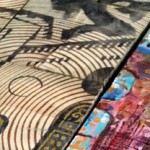In 2011 my wife and I spent a week in New York City. We stayed with a friend of a friend in the Bronx and took the subway into Manhattan each day where my wife was taking a class. I was just there to support her and had an entire week to simply roam the streets and explore NYC. It was glorious. On my first day there I was heading to the Brooklyn Bridge subway station when I heard a very familiar voice say, “Gimme a HOT dog. With MUStard.” I recognized the voice right away as belonging to Ice-T. I turned around and sure enough, there was Ice-T ordering from a street vendor.
I walked by thousands of people that week. Yet amid all the voices, sounds, and sights, I immediately recognized that one familiar and famous voice. The vast expanse of styles in God’s creation is amazing. The saying is that there’s nothing new under the sun. It’s all been done before. You would think that with the limited scope of the chromatic scale, we would have run out of new songs long ago. Or with rapid globalization, one would expect we all start to sound the same. Yet the new tunes keep coming, and Ice-T’s voice still stands as unique.
And so we’re able to pick out visual styles as well. Even when it comes to the ever-present subject matter of semi-abstract oil landscapes, an individual artist can be identified by her unique style when we’re familiar with her work.
While the adage of familiarity breeding contempt is true in many situations, it also provides comfort because we understand it. There are no significant unknowns. Keeping with the Ice-T theme, consider the television series, Law & Order. It’s been on the air since 1999 and the format is well known. Would you rather watch an episode of Law & Order or spend an hour watching a new crime drama about which you know nothing? Answers will vary, but when it comes down to it, my bet is that many of us would choose the sure and familiar option of Law & Order.
This is the second in a series on critique, and the fact is that we often give a free pass to artwork we’re familiar with. We leave it unchallenged. The radio plays it on heavy rotation and before long we download a copy. Or we say “Ah, that’s a Banksy. We like his work.” That’s not to say the familiar can’t be brilliant. However, past success should not earn future free passes.
That being said, the more significant application of this point is not so much what we do with familiar artwork, but what we do with the unfamiliar. We are inclined to not give unfamiliar artwork a fair shake. This is clearly seen as a common theme throughout history. From Warhol’s Campbell’s soup can to Dylan going electric, the unfamiliar can immediately feel preposterous, frivolous, unnecessary, or irrelevant. It’s uncomfortable, it’s unknown, and it’s going to take effort (and maybe time) to grasp.
But the unfamiliar is not necessarily bad. And understand that the unfamiliar is not totally new. There is no idea so outrageously novel that it is not based on what came before. There may be significant influences you are not acquainted with, but this is not a excuse for dismissal. Understanding the history of your field of art is crucial to understanding the present. In the end, your understanding of the piece and its evolutionary inspiration may be your reason for dismissing it—but you have then done so responsibly and fairly.
Here then is the lesson for the artist: be productive and be present. If your output is scanty, the recognition of your style will be low. If you’re looking for art to be more than a hobby and personal outlet, be productive. And equally as important—be present. Put your artwork in front of faces. Take advantage of social media. (Is self promotion wrong? That’s a whole other topic.) Make your style familiar.
The fact that people misuse familiarity in their critique does not make it a selling out process for the artist. It is vital. Dylan didn’t turn people on to his new style by only plugging in once in a while. And Warhol’s pop art production wasn’t an occasional experiment. Their unfamiliar styles would never have stood the test of time had they not “sold it” by making it familiar.
That last sentence begs me to add one more thought. Looking beyond purely artistic endeavors, familiarity is a powerful and dangerous tool when it comes to information and truth. Selling ideas by making them familiar is also a tactic used to spread falsehood and make it acceptable. It’s used to turn absolute truth into a lie. This is rampant in today’s culture and we all need to be on guard against it. To do that, we must remember this one truth that applies to art as well: the fact that an idea or practice is widely accepted in our culture counts for nothing when evaluating it’s value or propriety.
Next we’ll look at dealing with our own background.
Articles in this series on critique
- The Significance of Series
- The Farce of Familiarity
- The Bias of Background
- The Folklore of Fame



